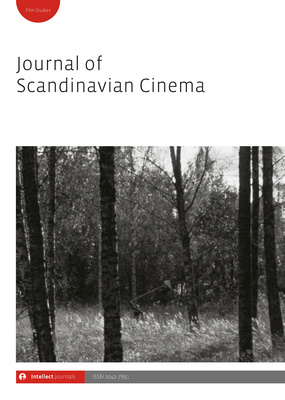
Journal of Scandinavian Cinema 8.3 is now available
Intellect is excited to announce that the Journal of Scandinavian Cinema 8.3 is now available!
For more information about the issue, click here >> https://www.intellectbooks.co.
Content
Editorial
Authors: Gunnar Iversen
Simmering with rage: Kitchens and intimate partner violence in Eva Sørhaug’s 90 Minutes
Authors: Melissa Gjellstad
This article examines domestic violence committed by white heterosexual men in a 2010s Norwegian film by a female director. This film stands out for its focus on male perpetrators, not female victims, contributing a fictional presentation of three men who struggle to meet societal norms for parents and partners in the Nordic gender-equal family of the twenty-first century. Eva Sørhaug’s use of cinematic space drills deep to probe the men’s pain, employing both the camera’s perspective and the significance of interiors of family homes to visually assess the male characters as they break. The socially constructed spaces of the kitchen and the bedroom augment tensions within the rigid confines of hegemonic masculinity and the men’s failure to attain those norms. The cinematic portrayal of intimate partner violence and homicide sheds light on male perpetrators and invokes societal culpability in the perpetuation of abuse.
Susanne Bier’s nomadic perspective on home
Authors: Missy Molloy
Film critics and scholars have frequently linked concepts of cinematic transnationalism to Susanne Bier’s films, which feature many characters in limbo, uncertain about which nation, culture and/or place they belong. This article proposes a nomadic dimension to the treatments of home, identity and intimacy in many films directed by Bier. Sensitivity to characters who have difficulty establishing permanent living spaces is particularly apparent in Bier films that utilize homes under renovation to model changes in characters’ circumstances, priorities and desires. Closely reading the erotics of design in Den eneste ene (The One and Only) (Bier, 1999) and Elsker dig for evigt (Open Hearts) (Bier, 2003) indicates an authorial predilection for homes under renovation never seen through to completion.
Tancred Ibsen’s failure to Ibsenize Hollywood
Authors: Gunnar Iversen
This short subject discusses Norwegian director Tancred Ibsen’s short period in the United States and Hollywood in the 1920s. According to his autobiography, his purpose was to ‘Ibsenize cinema’, but his stay in Hollywood was brief. New information on Ibsen’s Hollywood period is found by examining the outlines and synopses he wrote for MGM in 1924 and 1925, with a closer look at the synopsis Kin of Fame, a drama about identity and recognition with clear references to his own life.
Sexual violence, good taste and the education of the cinema audience: Gender and censorship in 1920s Sweden
Authors: Tommy Gustafsson And Mariah Larsson
This article makes use of records in the archive of Sweden’s National Board of Film Censorship for a discussion of the censorship of visual representations of sex and violence in films by women directors during the 1920s. From the perspective that Swedish film censorship was utilized to educate and control Swedish cinema audiences, not least concerning taste, the question is posed: how did gender and nationality play a role in the assessment of taste? Focusing on three case studies, namely Karin Swanström’s Kalle Utter (1925), Dorothy Arzner’s Manhattan Cocktail (1928) and Olga Preobrazhenskaya’s The Women of Ryazan (1927) and comparing censorship records with reviews in the daily press, the article demonstrates how nation played a role in the assessment of taste and the decisions to cut these films. The analyses also reveal that the censoring of sexual violence had a tendency to diminish acts such as rape and forced kissing in a narrative as well as on a moral level.
Hard facts, soft measures: Gender, quality and inequality debates in Danish film and television in the 2010s
Authors: Eva Novrup Redvall And Inge Ejbye Sørensen
This article investigates discussions about gender, quality and equality in Danish film and television in the 2010s. Contrary to Sweden, where gender diversity has been part of public debate and formal screen policy since the 2000s, there was little discussion of gender in the Danish screen industry until the Danish Film Institute (DFI) began focusing on diversity as a priority area before the Film Strategy for 2015–18. The article analyses how both DFI and industry players have continuously argued against gender quotas, instead opting for soft measures such as ‘gender declarations’ and initiatives to raise awareness. One of these initiatives was a manifesto, ManusFestet, that used humour to raise questions about gender representation on-screen. The article discusses how a balance between hard facts and soft measures seems to be experienced as a constructive way forward, as long as this combination does in fact facilitate the intended change.
Moral crusades in the East: Swedish filmmakers ‘going abroad to do good’
Authors: Olof Hedling
The article is an attempt to identify some common themes in a body of work while at the same time regarding Sweden as especially conducive to pessimism regarding the decline in the moral economy of the world. Ever since the collapse of the Soviet Union and the newfound independence of the Baltic states of Estonia, Latvia and Lithuania, Swedish filmmakers have repeatedly crossed the Baltic in search of subject matter not readily available in the supposedly well-ordered domestic setting. In these films, the former communist territories have almost invariably been imagined as marked by malaise, decay, a crumbling infrastructure and as destinations for sex tourism. Social security is undercut, poverty is rampant and phenomena such as prostitution, trafficking, drug use and child abandonment all seem to be on the rise. A famous example is Lukas Moodysson’s 2002 film Lilya 4-ever, the story of an abandoned teenage girl from the former Eastern bloc, who is manipulated into coming to Sweden as an involuntary sex worker. However, Moodysson’s film does not stand alone, but rather shares certain characteristics with other works exploring the Baltic connection.

